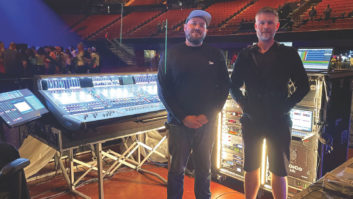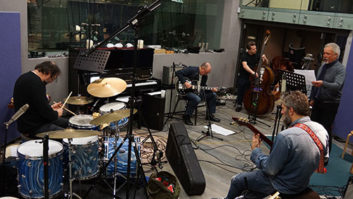The folks at Shure really know how to package a microphone to make one drool with anticipation. This mic looks good! Fortunately, the sleek look mirrors its fine performance, which is not entirely surprising, given Shure’s success with other condenser mic designs, such as the industry-standard SM85, SM87 and SM98.
The KSM32 comes in two flavors. The $1,029 full studio version-Model KSM32/SL has a champagne-colored finish and is supplied with an elastic-suspen-sion shock mount, a locking alu-minum carrying case, swiv- el mount, velveteen pouch and a fab-ulous little mic stand adapter for tight placement when the unit is used in cramped quarters, such as for hi-hat or tom miking. The $959 Model KSM32/ CG is the same mic but in a nonreflective, charcoal gray finish for stage applications; it ships with only the swivel mount and a pad-ded, zippered carry bag.
The elastic-suspension shock mount is fantastic. The mic slides easily into its holster, and five turns later you are ready to go. Plus, you can’t strip the shock-mount threads by turning it too much, so you can let your caffeine-crazed apprentice play with this toy. Once it’s seated, the base rotates freely with the mic, which makes positioning an absolute breeze.
The first thing I like to do to a (non-ribbon) mic I’m testing is to blow into it. The KSM32 handles gale-force garlic breath just like you’d expect a pro mic to. During this extreme torture, the distortion is there, but the capsule doesn’t bottom out. As an added bonus, the mic body takes well to handling. A firm tap yields only the slightest rumbling in the capsule. This is a very well-built mic with excellent capsule isolation, and it only weighs a bit over a pound.
The KSM32 is a single-pattern, cardioid condenser mic with transformerless preamp circuitry. The capsule features a gold-layered Mylar diaphragm and is reportedly capable of handling SPLs up to 133 dB. Frequency response is 20 to 20k Hz. A three-position switch selects between flat response and two low-frequency cutoffs: One is a -18dB/octave slope at 80 Hz; the other is a less aggressive -6dB/octave at 115 Hz. The cardioid pickup pattern attenuates sharply from the sides, aiding in isolation from other instruments.
The accompanying booklet mentions several different applications for this mic, mainly voice, acoustic instruments and ambient techniques like overheads for a drum kit. It also mentions low-frequency instruments like bass or kick drum.
I admit I was a little worried about putting a mic of this caliber in a kick drum. The mic has a switchable -15dB pad, which amazingly wasn’t really necessary. A bit of distortion reared its ugly head, but the mic held up well with and without the pad. The KSM32 was solid in the low-end department: The sound was round, fat and moved considerable air on the subwoofer. Only time will tell if the diaphragm will hold up to repeated punishment.
Testing the KSM32 mic on female and male vocals, I found the male voice to be rich, present and well-rounded in all frequencies, basically a “snapshot” of the live voice. The female voice was also well-rounded, with a high-end sparkle that is a signature of female vocals in the mid to high register. The KSM32 proved an excellent choice for vocals when clarity is of the essence.
Another shining aspect of this mic is its ability to focus an overhead track on a drum kit. I may even go so far as to say this is the only mic you need to record drums. You know how natural those mid-’60s jazz recordings sounded? Remember how the drums sounded like a single instrument, rather than seven? This provides the modern equivalent!
I also tried the KSM32 on electric bass. In this application I was most impressed; the KSM32 gave the bass a well-defined low end yet retained the snappy high end necessary to assist the instrument in the fight for air space in the final mix. The KSM32 captured the bass in all its glory, reminding me of the day I first heard the album Soma Holiday by Proletariat. That album was recorded by Jimmy Dufour and Lou Giordano, and has always been a personal reference point for great bass sound. Indeed, this would be my mic of choice for bass, electric or acoustic.
Used close-up on a loud electric guitar amp, however, the sound was not as great. The mic didn’t break up under the pressure and could handle the SPL with the help of the -15dB pad, but in close-miking, I preferred a Shure SM57 on this particular cabinet. I also tried the KSM32 as an ambient mic on electric guitar. It sounded great and was true to the sound I heard while the guitar was being played.
Testing the KSM32 on several other instruments (violin, contrabass, trumpet, flute, piano and hand percussion), I found that it captures the true sound of most instruments in an open, ambient miking style evoking the warmth, smoothness and natural energy of most acoustic instruments. You may prefer a different mic to provide an “edgy” sound on your guitar or percussion tracks, but if you want a fairly accurate picture of your source with the rough edges taken off, this is your mic.
One last experiment I tried was to test the focus of the mic in an extreme ambient setting. The mic was placed at the end of a 100-foot, cement-and-drywall hallway that connects my studio to the outside world. I played a tape with all manner of feedback madness at the opposite end of the hallway while the Climax Golden Twins went plink-a-plink on a roachaphone and ukulele (no waffle irons this time). Lo and behold, with all the racket that tape deck was making, the plink-a-plinks could still be discerned beautifully. And if that weren’t enough, each member of the Twins walked closer to the mic during the course of the recording, plink-a-plinks a-plinking away. The stringed instruments be- came much more prominent, of course, yet each individual sound remained focused. Quite amazing. It certainly passed the mono mic test.
All in all, the KSM32 is a reasonably priced condenser mic that holds its own on a variety of instruments. I was most impressed with its bass response and ambient clarity. Would you expect less from Shure? I think not.
Shure Brothers Inc., 222 Hartrey Ave., Evanston, IL 60202. Phone 847/ 866-2200; fax 847/866-2279; Web site: www.shure.com.


